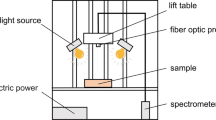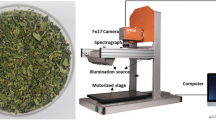Abstract
Chili oil, which contains large amounts of capsaicin and capsorubin, is one of the most consumed seasonings in China. These compounds significantly affect the quality, antioxidant activity, pungency, and color of chili oil. This study aimed to investigate the effect of stewing temperature, stewing time, and amount of oil on the capsaicin and capsorubin contents of Chinese chili oil. The partial least squares (PLS) regression and genetic algorithm–artificial neural network models were established and used to predict capsaicin and capsorubin contents. The genetic algorithm was applied to optimize the parameters of the network. The developed genetic algorithm–artificial neural network, which included ten hidden neurons, predicted capsaicin and capsorubin contents with correlation coefficients of 0.995 and 0.986, respectively. The neural network exhibited more accurate prediction and practicability compared with the PLS regression model.









Similar content being viewed by others
References
Barbero GF, Ruiz AG, Liazid A, Palma M, Vera JC, Barroso, CG (2014) Evolution of total and individual capsaicinoids in peppers during ripening of the Cayenne pepper plant (Capsicum annuum L.). Food Chemi 153:200–206
Bardot I, Martin N, Trystram G, Hossenlopp J, Rogeaux M, Bochereau L (1994) A new approach for formulation of beverages. Part II: interactive automatic method. Lebensm Wiss Technol 27:513–521
Bramley PM (2000) Is lycopene beneficial to human health? Phytochemistry 54:233–236
Chen Q, Zhao J, Liu M, Cai J, Liu J (2008) Determination of total polyphenols content in green tea using FT-NIR spectroscopy and different PLS algorithms. J Pharm Biomed Anal 46:568–573
Chen J, Ren X, Zhang Q, Diao X, Shen Q (2013) Determination of protein, total carbohydrates and crude fat contents of foxtail millet using effective wavelengths in NIR spectroscopy. J Cereal Sci 58:241–247
Daood HG, Kapitány J, Biacs P, Albrecht K (2006) Drying temperature, endogenous antioxidants and capsaicinoids affect carotenoid stability in paprika red pepper spice. J Sci Food Agric 86:2450–2457
Deepa N, Kaur C, Binoy G, Balraj S, Kapoor HC (2007) Antioxidant constituents in some sweet pepper (Capsicum annum L.) genotypes during maturity. LWT-Food Sci Technol 40:121–129
Dornier M, Decloux M, Trystram G, Lebert A (1995) Dynamic modeling of crossflow microfiltration using neural networks. J Membr Sci 98:263–273
Frank AC, Nelson GR, Simonne HE, Behe KB, Simonne HA (2001) Consumer preferences for color, price, and vitamin C content of bell peppers. Hortscience 36:795–800
Gillespie GD, Everard CD, McDonnell KP (2015) Prediction of biomass pellet quality indices using near infrared spectroscopy. Energy 80:582–588
Gonzalez-Zamora A, Sierra-Campos E, Guadalupe Luna-Ortega J, Perez-Morales R, Rodriguez Ortiz JC, Garcia-Hernandez JL (2013) Characterization of different capsicum varieties by evaluation of their capsaicinoids content by high performance liquid chromatography, determination of pungency and effect of high temperature. Molecules 18(11):13471–13486
Harris JR (1996) Ascorbic acid: biochemistry and biomedical cell biology. In: Harris JR (ed) Subcellular biochemistry. Plenum Press, New York, p 25
Hayashi T, Hayashi K, Fujita J, Ono M, Oka H, Ito Y, Matsumoto H, Ozeki N, Itakura Y, Nakazawa H (2001) An HPLC method for the analysis of paprika color in food using capsanthin as an indicator. J Liquid Chromatog Relat Technol 24(15):2347–2361
Hosu A, Cristea V-M, Cimpoiu C (2014) Analysis of total phenolic, flavonoids, anthocyanins and tanninscontent in Romanian red wines: prediction of antioxidant activitiesand classification of wines using artificial neural networks. Food Chem 150:113–118
Islama MA, Sharmaa SS, Sinhaa P, Negia MS, Neogb B, Tripathi SB (2015) Variability in capsaicinoid content in different landraces of Capsicum cultivated in northeastern India. Sci Hortic 183:66–71
José Antonio R-U, Jorge Iván N-P, Claudia Araceli R-M (2014) Cost estimation for CO2 supercritical extraction systems and manufacturing cost for habanero chiliJosé. J Supercritical Fluids 93:38–41
Kapoor V, Dey S, Khurana AP (2010) Empirical analysis and random respectful recombination of crossover and mutation in genetic algorithms. Int J Comput Appl 1:25–30
Lertworasirikul S, Saetan S (2010) Artificial neural network modeling of mass transfer during osmotic dehydration of kaffir lime peel. J Food Eng 90:214–223
Majdi A, Beiki M (2010) Evolving neural network using a genetic algorithm for predicting the deformation modulus of rock masses. Int J Rock Mechanics Mining Sci 47:246–253
Mateos RM, León AM, Sandalio LM, Gómez M, del Río LA, Palma JM (2003) Peroxisomes from pepper fruits (Capsicum annum L.): purification, characterisation and antioxidant activity. J Plant Physiol 160:1507–1516
Meng X, Zhang M, Adhikari B (2012) Prediction of storage quality of fresh-cut green peppers using artificial neural net work. Int J Food Sci Technol 47:1586–1592
Mohebbi M, Fathi M, Shahidi F (2011) Genetic Algorithm–Artificial Neural Network Modeling of Moisture and Oil Content of Pretreated Fried Mushroom. Food Bioprocess Technol 4:603–609
Morimoto T (2006) Genetic algorithm. In: Sablani SS, Rahman MS, Datta AK, Mujumdar AS (eds) Food and bioprocess modeling Techniques. CRC, New York
Nathália Cristina Torres M, de Almeida Teixeira GH, de Lima KMG, Thayara Bittencourt M, Viviani N, Luís Carlos Cunha J (2015) NIRS and iSPA-PLS for predicting total anthocyanin content in jaboticaba fruit. Food Chem 174:643–648
Nelson E, Dawson L (1923) Constitution of capsaicin, the pungent principle of Capsicum. III. J Am Chem Soc 45:2179–2181
Oboh G, Puntel RL, Rocha JBT (2007) Hot pepper (Capsicum annuum, Tepin and Capsicum chinese, Habanero) prevents Fe2+-induced lipid peroxidation in brainin vitro. Food Chem 102:178–185
Shakhidoyatov RK, Sagdullaev BT (2001) Capsaicine in capsicum annuum condensed extract determined by HPLC. Chem Nat Compd 37:575–576
Shankar TJ, Sokhansanj S, Bandyopadhyay S, Bawa AS (2010) A case study on optimization of biomass flow during single-screw extrusion cooking using genetic algorithm (GA) and response surface method (RSM). Food Bioprocess Technol 3:498–510
Shim Y-S, Kim K-J, Ito DSM, Nakagawa H, Arai S, Ha J (2013) Simultaneous determination of free capsorubin and capsanthin in red pepper powder using u-HPLC. Food Composition Additives 96:341–345
Suna K, Youl Ha T, Park J (2008) Characteristics of pigment composition and colour value by the difference of harvesting times in Korean red pepper varieties (Capsicum annuum, L.). J Eur Food Res Technol 43:915–920
Wang D, Bosland PW (2006) The genes of Capsicum. Hort Sci 41:1169–1187
Acknowledgments
This study was financially supported by the National Key Technology R&D Program (2012BAD31B08) and National science and technology program (2012BAD27B00). The authors gratefully acknowledge the members of the Hubei Food and Fermentation Engineering Technology Research Centre.
Author information
Authors and Affiliations
Corresponding author
Ethics declarations
Funding
We have received research grants from National Key Technology R&D Program (2012BAD31B08) and National science and technology program (2012BAD27B00).
Conflict of Interest
Cheng Ding declares that there is no conflict of interest. Libin Xu declares that there is no conflict of interest. Na Zhou declares that there is no conflict of interest. Yang Chen declares that there is no conflict of interest. Dongsheng Li declares that there is no conflict of interest. Ning Xu declares that there is no conflict of interest. Yong Hu declares that there is no conflict of interest. Yueze Cao declares that there is no conflict of interest. Chao Wang declares that there is no conflict of interest.
Ethical Approval
This article does not contain any studies with animals performed by any of the authors.
Informed Consent
Informed consent was obtained from all individual participants included in the study.
Rights and permissions
About this article
Cite this article
Ding, C., Xu, L., Zhou, N. et al. Genetic Algorithm–Artificial Neural Network Modeling of Capsaicin and Capsorubin Content of Chinese Chili Oil. Food Anal. Methods 9, 2076–2086 (2016). https://doi.org/10.1007/s12161-015-0392-3
Received:
Accepted:
Published:
Issue Date:
DOI: https://doi.org/10.1007/s12161-015-0392-3




